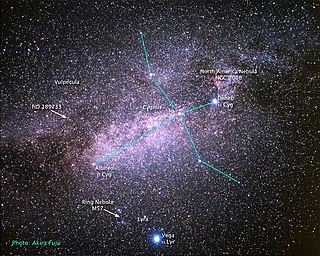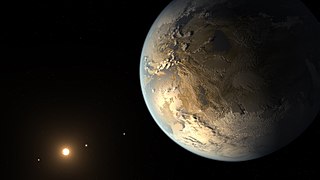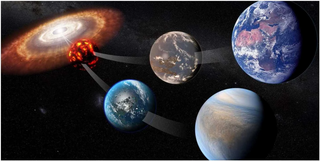
There are several methods currently used by astronomers to detect distant exoplanets from Earth. [1] Theoretically, some of these methods can be used to detect Earth as an exoplanet from distant star systems.

There are several methods currently used by astronomers to detect distant exoplanets from Earth. [1] Theoretically, some of these methods can be used to detect Earth as an exoplanet from distant star systems.

In June 2021, astronomers identified 1,715 stars (with likely related exoplanetary systems) within 326 light-years (100 parsecs) that have a favorable positional vantage point—in relation to the Earth Transit Zone (ETZ)—of detecting Earth as an exoplanet transiting the Sun since the beginnings of human civilization (about 5,000 years ago); an additional 319 stars are expected to arrive at this special vantage point in the next 5,000 years. [2] Seven known exoplanet hosts, including Ross 128, may be among these stars. Teegarden's Star and Trappist-1 may be expected to see the Earth in 29 and 1,642 years, respectively. Radio waves, emitted by humans, have reached over 75 of the closest stars that were studied. [2] In June 2021, astronomers reported identifying 29 planets in habitable zones that may be capable of observing the Earth. [3] Earlier, in October 2020, astronomers had initially identified 508 such stars within 326 light-years (100 parsecs) that would have a favorable positional vantage point—in relation to the Earth Transit Zone (ETZ)—of detecting Earth as an exoplanet transiting the Sun. [4] [5] [6] [7]
Transit method is the most popular tool used to detect exoplanets and the most common tool to spectroscopically analyze exoplanetary atmospheres. [4] As a result, such studies, based on the transit method, will be useful in the search for life on exoplanets beyond the Solar System by the SETI program, Breakthrough Listen Initiative, as well as upcoming exoplanetary TESS mission searches. [4]
Detectability of Earth from distant star-based systems may allow for the detectability of humanity and/or analysis of Earth from distant vantage points such as via "atmospheric SETI" for the detection of atmospheric compositions explainable only by use of (artificial) technology like air pollution containing nitrogen dioxide from e.g. transportation technologies. [8] [9] [10] The easiest or most likely artificial signals from Earth to be detectable are brief pulses transmitted by anti-ballistic missile (ABM) early-warning and space-surveillance radars during the Cold War and later astronomical and military radars. [11] [12] Unlike the earliest and conventional radio- and television-broadcasting which has been claimed to be undetectable at short distances, [13] [14] such signals could be detected from very distant, possibly star-based, receiver stations – any single of which would detect brief episodes of powerful pulses repeating with intervals of one Earth day – and could be used to detect both Earth as well as the presence of a radar-utilizing civilization on it. [15]
Studies have suggested that radio broadcast leakage – with the program material likely not being detectable – may be a technosignature detectable at distances of up to a hundred light years with technology equivalent to the Square Kilometer Array [16] if the location of Earth is known. [17] [18] [12] Likewise, if Earth's location can be and is known, it may be possible to use atmospheric analysis to detect life or favorable conditions for it on Earth via biosignatures, including MERMOZ instruments that may be capable of remotely detecting living matter on Earth. [19] [20] [21]
In 1980s, astronomer Carl Sagan persuaded NASA to perform an experiment of detecting life and civilization on Earth using instruments of the Galileo spacecraft. It was launched in December 1990, and when it was 960 km from the planet's surface, Galileo turned its instruments to observe Earth. Sagan's paper was titled "A search for life on Earth from the Galileo spacecraft"; he wrote that "high-resolution images of Australia and Antarctica obtained as Galileo flew overhead did not yield signs of civilization"; other measurements showed the presence of vegetation and detected radio transmissions. [22] [23]

The Drake equation is a probabilistic argument used to estimate the number of active, communicative extraterrestrial civilizations in the Milky Way Galaxy.

An exoplanet or extrasolar planet is a planet outside the Solar System. The first possible evidence of an exoplanet was noted in 1917 but was not recognized as such. The first confirmation of the detection occurred in 1992. A different planet, initially detected in 1988, was confirmed in 2003. As of 1 December 2023, there are 5,550 confirmed exoplanets in 4,089 planetary systems, with 887 systems having more than one planet. The James Webb Space Telescope (JWST) is expected to discover more exoplanets, and also much more about exoplanets, including composition, environmental conditions and potential for life.

HD 209458 b is an exoplanet that orbits the solar analog HD 209458 in the constellation Pegasus, some 157 light-years from the Solar System. The radius of the planet's orbit is 0.047 AU, or one-eighth the radius of Mercury's orbit. This small radius results in a year that is 3.5 Earth-days long and an estimated surface temperature of about 1,000 °C. Its mass is 220 times that of Earth and its volume is some 2.5 times greater than that of Jupiter. The high mass and volume of HD 209458 b indicate that it is a gas giant.
A biosignature is any substance – such as an element, isotope, molecule, or phenomenon that provides scientific evidence of past or present life. Measurable attributes of life include its complex physical or chemical structures, its use of free energy, and the production of biomass and wastes. A biosignature can provide evidence for living organisms outside the Earth and can be directly or indirectly detected by searching for their unique byproducts.

An exomoon or extrasolar moon is a natural satellite that orbits an exoplanet or other non-stellar extrasolar body.

HD 189733, also catalogued as V452 Vulpeculae, is a binary star system 64.5 light-years away in the constellation of Vulpecula. The primary star is suspected to be an orange dwarf star, while the secondary star is a red dwarf star. Given that this system has the same visual magnitude as HD 209458, it promises much for the study of close transiting extrasolar planets. The star can be found with binoculars 0.3 degrees east of the Dumbbell Nebula (M27).

Abraham "Avi" Loeb is an Israeli-American theoretical physicist who works on astrophysics and cosmology. Loeb is the Frank B. Baird Jr. Professor of Science at Harvard University, where since 2007 he has been Director of the Institute for Theory and Computation at the Center for Astrophysics. He chaired the Department of Astronomy from 2011–2020, and founded the Black Hole Initiative in 2016.

These are lists of exoplanets. As of 19 December 2023, there are 5,566 confirmed exoplanets in 4,140 planetary systems, with 942 systems having more than one planet. Most of these were discovered by the Kepler space telescope. There are an additional 1,984 potential exoplanets from Kepler's first mission yet to be confirmed, as well as 977 from its "Second Light" mission and 4,589 from the Transiting Exoplanet Survey Satellite (TESS) mission.

Any planet is an extremely faint light source compared to its parent star. For example, a star like the Sun is about a billion times as bright as the reflected light from any of the planets orbiting it. In addition to the intrinsic difficulty of detecting such a faint light source, the light from the parent star causes a glare that washes it out. For those reasons, very few of the exoplanets reported as of April 2014 have been observed directly, with even fewer being resolved from their host star.

HD 189733 b is an exoplanet in the constellation of Vulpecula approximately 64.5 light-years away from our Solar System. Astronomers in France discovered the planet orbiting the star HD 189733 on October 5, 2005, by observing its transit across the star's face. With a mass 11.2% higher than that of Jupiter and a radius 11.4% greater, HD 189733 b orbits its host star once every 2.2 days at an orbital speed of 152.0 kilometers per second, making it a hot Jupiter with poor prospects for extraterrestrial life.

HAT-P-11b is an extrasolar planet orbiting the star HAT-P-11. It was discovered by the HATNet Project team in 2009 using the transit method, and submitted for publication on 2 January 2009.

An Earth analog, also called an Earth analogue, Earth twin, or second Earth, is a planet or moon with environmental conditions similar to those found on Earth. The term Earth-like planet is also used, but this term may refer to any terrestrial planet.

An exoplanet is a planet located outside the Solar System. The first evidence of an exoplanet was noted as early as 1917, but was not recognized as such until 2016; no planet discovery has yet come from that evidence. What turned out to be the first detection of an exoplanet was published among a list of possible candidates in 1988, though not confirmed until 2003. The first confirmed detection came in 1992, with the discovery of terrestrial-mass planets orbiting the pulsar PSR B1257+12. The first confirmation of an exoplanet orbiting a main-sequence star was made in 1995, when a giant planet was found in a four-day orbit around the nearby star 51 Pegasi. Some exoplanets have been imaged directly by telescopes, but the vast majority have been detected through indirect methods, such as the transit method and the radial-velocity method. As of 1 December 2023, there are 5,550 confirmed exoplanets in 4,089 planetary systems, with 887 systems having more than one planet. This is a list of the most notable discoveries.

Lisa Kaltenegger is an Austrian world-leading astronomer with expertise in the modeling and characterization of exoplanets and the search for life. On July 1, 2014, she was appointed Associate Professor of Astronomy at Cornell University. Previously, she held a joint position at the Max Planck Institute for Astronomy in Heidelberg where she was the Emmy Noether Research Group Leader for the "Super-Earths and Life" group, and at the Center for Astrophysics | Harvard & Smithsonian in Cambridge, MA. She was appointed Lecturer in 2008 at Harvard University and 2011 at University of Heidelberg.

Technosignature or technomarker is any measurable property or effect that provides scientific evidence of past or present technology. Technosignatures are analogous to biosignatures, which signal the presence of life, whether intelligent or not. Some authors prefer to exclude radio transmissions from the definition, but such restrictive usage is not widespread. Jill Tarter has proposed that the search for extraterrestrial intelligence (SETI) be renamed "the search for technosignatures". Various types of technosignatures, such as radiation leakage from megascale astroengineering installations such as Dyson spheres, the light from an extraterrestrial ecumenopolis, or Shkadov thrusters with the power to alter the orbits of stars around the Galactic Center, may be detectable with hypertelescopes. Some examples of technosignatures are described in Paul Davies's 2010 book The Eerie Silence, although the terms "technosignature" and "technomarker" do not appear in the book.

Kepler-438b is a confirmed near-Earth-sized exoplanet. It is likely rocky. It orbits on the inner edge of the habitable zone of a red dwarf, Kepler-438, about 472.9 light-years from Earth in the constellation Lyra. It receives 1.4 times our solar flux. The planet was discovered by NASA's Kepler spacecraft using the transit method, in which the dimming effect that a planet causes as it crosses in front of its star is measured. NASA announced the confirmation of the exoplanet on 6 January 2015.
The Carl Sagan Institute: Pale Blue Dot and Beyond was founded in 2014 at Cornell University in Ithaca, New York to further the search for habitable planets and moons in and outside the Solar System. It is focused on the characterization of exoplanets and the instruments to search for signs of life in the universe. The founder and current director of the institute is astronomer Lisa Kaltenegger.

Stephen Kane is a full professor of astronomy and planetary astrophysics at the University of California, Riverside who specializes in exoplanetary science. His work covers a broad range of exoplanet detection methods, including the microlensing, transit, radial velocity, and imaging techniques. He is a leading expert on the topic of planetary habitability and the habitable zone of planetary systems. He has published hundreds of peer reviewed scientific papers and has discovered/co-discovered several hundred planets orbiting other stars. He is a prolific advocate of interdisciplinarity science and studying Venus as an exoplanet analog.

Over the years, our ability to detect, confirm, and characterize exoplanets and their atmospheres has improved, allowing researchers to begin constraining exoplanet interior composition and structure. While most exoplanet science is focused on exoplanetary atmospheric environments, the mass and radius of a planet can tell us about a planet's density, and hence, its internal processes. The internal processes of a planet are partly responsible for its atmosphere, and so they are also a determining factor in a planet's capacity to support life.
While the limits of detection of Earth's radio transmissions are a subject of debate (Sullivan argues ~25 light-years, Atri et al. (2011) and Baum et al. (2011) up to 100 light years), as they largely depend on the size of the receiving antenna